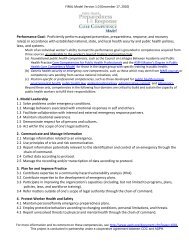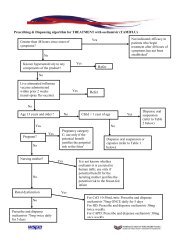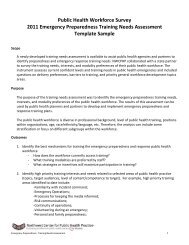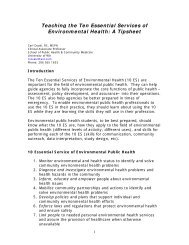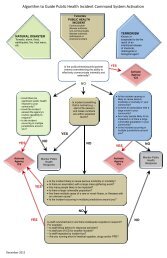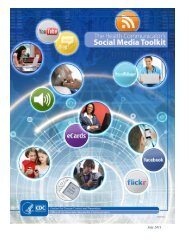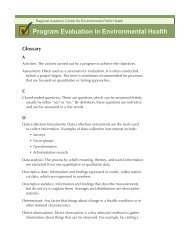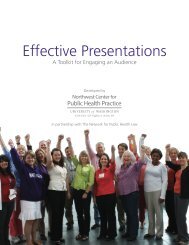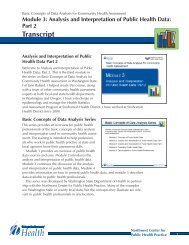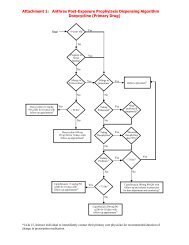Effective Adult Learning - Northwest Center for Public Health Practice
Effective Adult Learning - Northwest Center for Public Health Practice
Effective Adult Learning - Northwest Center for Public Health Practice
Create successful ePaper yourself
Turn your PDF publications into a flip-book with our unique Google optimized e-Paper software.
How do I develop learning objectives?<br />
Developing effective objectives that get to the purpose of<br />
your training is not easy. But you can do it by following a<br />
few simple steps. Objectives should be written from the<br />
participants’ point of view. They should emphasize what<br />
you want students to value, understand or do with the<br />
in<strong>for</strong>mation or skills being taught.<br />
According to Robert Mager, a world-renowned expert<br />
in instructional design, the simplest way to start writing<br />
learning objectives is by answering three questions:<br />
1. What will participants be able to do as a result of the<br />
course, training, or class?<br />
2. What are the conditions or circumstances where<br />
the participants will per<strong>for</strong>m this activity, and what<br />
knowledge or materials does he/she need to do this<br />
effectively?<br />
3. What level of proficiency is needed to per<strong>for</strong>m the<br />
task or skill successfully or apply this in<strong>for</strong>mation?<br />
There are several different models that have been created<br />
to help in designing learning objectives. For developing<br />
practical objectives, you might consider the SMART Model.<br />
For considering objectives that may relate more to behavior<br />
change, you might consider the A-B-C-D Model.<br />
See Section 2: <strong>Learning</strong> Objectives In-Depth, <strong>for</strong> more<br />
detail on how to write effective objectives and to see<br />
“be<strong>for</strong>e” and “after” examples.<br />
What kind of training should I develop?<br />
Will it be a one-time course or a series? Will it be face-toface,<br />
online, or blended? How intensive, basic, or elaborate<br />
your training will be depends on determining the following:<br />
• What resources are available?<br />
• What are some potential challenges to this training<br />
(<strong>for</strong> example, <strong>for</strong>mat, class size, minimal resources)?<br />
• What content needs to be created?<br />
<strong>Learning</strong> Objective<br />
Tips<br />
SMART Model<br />
This model is used to<br />
build practical objectives.<br />
S is <strong>for</strong> Specific; specify<br />
what to achieve.<br />
M is <strong>for</strong> Measurable.<br />
A is <strong>for</strong> Achievable.<br />
R is <strong>for</strong> Relevant.<br />
T is <strong>for</strong> Time-bound.<br />
A-B-C-D Model<br />
This model is often<br />
used to build behavioral<br />
objectives.<br />
A is <strong>for</strong> Audience. State<br />
the learning audience<br />
within the objective.<br />
B is <strong>for</strong> Behavior. State<br />
the behavior you wish to<br />
see exhibited.<br />
C is <strong>for</strong> Condition. State<br />
the conditions where the<br />
behavior will occur.<br />
D is <strong>for</strong> Degree. To what<br />
degree will the learner be<br />
enabled?<br />
• What evaluation instruments need to be created?<br />
www.nwcphp.org <strong>Effective</strong> <strong>Adult</strong> <strong>Learning</strong>: A Toolkit <strong>for</strong> Teaching <strong>Adult</strong>s | 7




